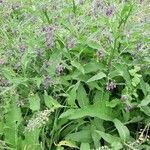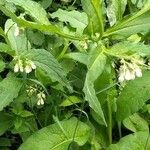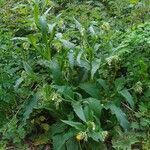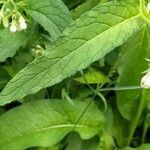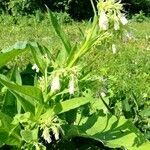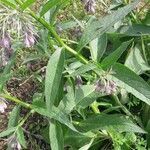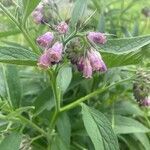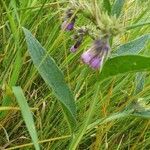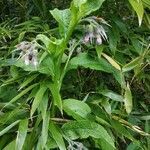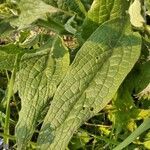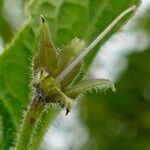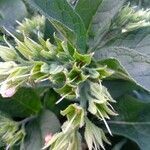Plants to c. 100 cm tall, with most vegetative parts strongly hispid. Roots becoming very thick. Basal lvs with lamina very large, ovate to ovatelanceolate, densely hispid above and below, but not harshly scabrid, often some hairs with bulbous bases but never predominantly so; cauline lvs smaller, mostly 3-4 mm wide, decurrent down stem to internode below, with petiole broadly winged, the upper sessile. Cymes densely hispid. Calyx 5-8 mm long, lobed to c. 3/4 length; lobes linear-lanceolate, ± shortly acuminate. Corolla 12-16 mm long, usually pale pink in upper 1/2, occasionally creamy white, purplish when dry; scales narrow-triangular. Filaments ± as wide as anthers; anthers usually projecting well beyond scales. Nutlets smooth.
Taprooted perennial 3–12 dm; stem and infl hispid-hirsute with spreading or recurved, subterete hairs; lvs large, the basal petiolate, with ovate or lance-ovate blade 15–30 ×7–12 cm, the cauline gradually reduced but still ample, the upper commonly sessile; stem evidently winged by the conspicuous decurrent lf-bases; cal 5–7 mm, cleft to below the middle; cor ochroleucous or dull blue, 12–18 mm; filaments as wide as the anthers; connective projecting beyond the thecae; nutlets 5–6 mm, black, very smooth, shining; 2n=24–54. Native of Eurasia, escaped or adventive in waste places here and there in our range. June–Aug.
A low clumpy plant with large long rough leaves. A dense crown of leaves and shoots develops. Plants are 30-90 cm tall. Leaves are 30-60 cm long and 10-20 cm wide. Lower leaves have leaf stalks and are branched. The inner leaves do not have leaf stalks. The flower stalk has many flowers. The flowers are purple, red or yellowish white. The nutlets are black, oval, 3-4 mm across and smooth an shiny.
